Porcelain Insulator News
by Elton Gish
Reprinted from "Crown Jewels of the Wire", September 1994, page 11
The Denver National Show in 1993 was a good show for porcelain insulators
with several old classic styles showing up that were very familiar but seldom
seen these days. I picked up a nice tan Imperial U-746 with Imperial
"crown" logo marking, but the typical thick tan glaze made it
difficult to read and half obliterated the manufacturing date, too. The date was
probably in 1904. Some of the U-935A specimens are unmarked, and the marked ones
only have a manufacturing date which is attributed to Imperial. I have one
specimen with the manufacturing date of "3-9-97". All of the U-935A' s
that I have seen were marked with one of the dates from March 8, 9, 10, or 11,
1897. It is odd that the only known dates happen to be sequential. All specimens
must have come from the same line or area.
The U-935A' s were first reported in "Porcelain Insulator News" in
May 1974, again in October 1978, and lastly in April 1981. U-935A, U-935B, and
sandy-tan U-746's with "New Lexington, O." marking were found along the
same lines from Ogden to Salt Lake City, Utah. The New Lexington insulators have
especially beautiful very light, finely speckled, sandy-tan glazes which made
them doubly desirable. We all know how rare the marking is on any insulator.
I nearly passed on purchasing
an unmarked white U-935A at the Denver show, but decided there was something
different enough to add it to my collection. Without a marked specimen for
comparison, the unmarked specimen appeared identical to the marked U-935A's
except for one small detail. The insulator was obviously made of dry process
porcelain! The bottom surface of the skirts was unglazed to form the firing rest
(the firing rest was on the top of the crown on the marked specimens), and the
texture of the dry process porcelain was easily observed. When I got home I
compared the insulator with the wet process Imperial (dated) version. They were
identical in almost every respect. What is going on here? Maybe you can see the
subtle differences around the crown in the photographs. The unmarked dry process
specimen has straighter ear lugs, two mold line marks across the cable groove, a
horizontal mold line mark under the ear lugs, and a mold line mark arcing down
at the end of the cable groove. Also, the inner skirt of the Imperial specimen
extends down whereas the skirts of the dry process specimen are nearly flush.
There are two trade journal articles that help explain why these two types of
U-935A were found on the same lines in the Ogden/Salt Lake City area. The
September 26, 1896 issue of Electrical World described a 15,000 volt 36-mile
line that was being built from Ogden to Salt Lake City. It was scheduled to
start operation in November 1896 with part of the power continuing south of Salt
Lake City, at 25,000 volts, to the Mercur mines. The line wires were
"strung on insulators of a special porcelain developed by the General
Electric Company to withstand high potentials." An article in the March 30,
1901 issue of the Electrical World & Engineer said that, "The
insulators on the Big Cottonwood line were among the first high-tension
insulators turned out and were made by the dry process." The Big
Cottonwood line was installed in June 1896 just southeast of Salt Lake City. The
article continued with, "Fully one third of them had to be replaced [with
Imperial insulators]. The insulators on the Ogden line were made by the Imperial
Porcelain Works, and tested to 50,000 volts, as were those on the Utah
line." This refers to replacing one-third of the dry process insulators on
the Big Cottonwood line with Imperial insulators. This must have been quite an
embarrassment to General Electric which did turn out some nice dry process
insulators. Other General Electric styles are U-744 and very possibly U-701.
Fred Locke also recognized the problems with dry process insulators in late 1895
when he began ordering insulators from Imperial.
The dry process General Electric insulator must be the unmarked U-935A and
the Imperial insulators are the wet process ones with the March 1897 dates. The
replacement of the General Electric insulators occurred in late March or April
1897 as evidenced by the early March 1897 dates on Imperial U-935A insulators. U-935B' s were also found in the
Ogden area which have the Imperial dates of May
6 and 8, 1897 and July 3 and 13, 1897. The four small ear lugs of U-935A probably
broke off easily so Imperial strengthened the crown by combining them into one
ear lug on opposite sides. This was Imperial's standard for tie-wire attachment
before July 1897. Other "eared" Imperial styles are U-924 and U-930.
The easily chipped delicate "ear" design was replaced in 1897 by more
modern looking crowns with a tie-wire groove. The change was probably influenced
by Fred Locke's cross-top U-923 and U-923A which was the first porcelain
insulator he had made by Imperial. Imperial's first large insulator with a
tie-wire groove was U-937 (an 1896 Fred Locke design), then U-934, and U-935
which was apparently introduced in July 1897.
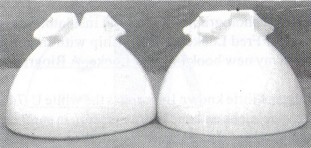
(Left) Wet process Imperial U-935A and
(Right) dry process General Electric
U-935A.
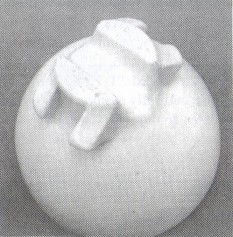 |
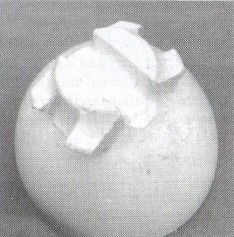 |
|
Notice mold lines around crown of General Electric U-935A (right) compared to
crown of Imperial U-935A (left). |
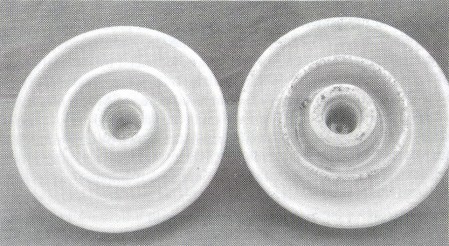
Wet process Imperial U-935A (left) and dry process
General Electric U-935A
(right). Note the obvious dry
process inner skirts of the General Electric
version.
Many more details and photographs of Imperial insulators and a discussion of
new evidence of Fred Locke's relationship with Imperial and Thomas can be found
in my new book Fred M. Locke. A Biography (see advertisement).
Another
interesting and little known Imperial is the white U-746. I know of only four or
five specimens and one is in a museum in southern California, where most if not
all specimens were found. You may have one and not realize it. Everyone has seen
numerous white U-935's which are the most common Imperial insulator with the
"crown" logo marking. I have been recording Imperial manufacturing
dates for the past 10 years. My records show as many as 53 different
manufacturing dates have been reported on U-935 specimens from July 16,1897 to
July 29, 1899. One unusual brown specimen was dated "1-13-02". When
someone mentions an Imperial U-746, we naturally assume that it has a brown
glaze. Brown specimens have been found with dates of 11-23-01,12-20-01,3-4-02,
and 1-18-03. The white U-746's look like U-935 except for the larger crown
design. Based on the manufacturing dates, it appears that U-746 replaced U-935
in 1899.
Indeed, the 33,000 volt Redlands line with U-746's was put in service
in February 1899. The following account was taken from the January 1903 issue of
the Journal of Electricity. Power and Gas. The Redlands Electric Light and Power
Co. built the original line from Mill Creek to Redlands, CA. The 16-mile 10,000
volt line was put into service on November 7, 1893 making it the first 3-phase power system in the
US. The insulator used was CD 178.
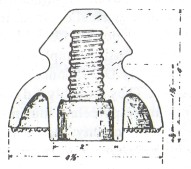
CD 178
The article shows an illustration of this
insulator with drip points, so the Hemingray style must have been used. In 1896
the line was extended from Redlands to Colton and Riverside using Fred Locke's
Imperial made U-923A insulators. In December 1896 the Redlands company organized
the Southern California Power Co. (later changed to the Edison Electric Co.)
which would build a power plant at Santa Ana Canyon and run two parallel 33,000
volt lines 82 miles to Los Angeles.
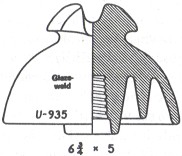 |
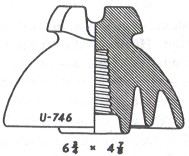 |
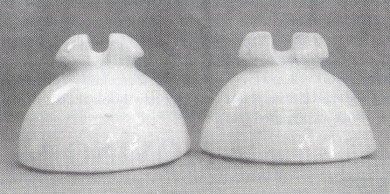
Imperial U-935 (left) and Imperial U-746 (right) |
Electrical manufacturing companies strongly objected to the transmission
voltage stating that the weakest part of the line would be the insulators, even if a suitable insulator could be found. Mr. O. H. Ensign was
the electrical engineer in charge of the line. A representative of the C. S.
Knowles Co. of Boston, agent for Imperial Porcelain Works, gave Mr. Ensign
samples of Imperial porcelain insulators. This insulator was surely U-935 since
the final design was the same except for the crown. They probably did not submit
U-934 because it contained almost 50% more porcelain thus making it more
expensive to make and ship across the county. Mr. Ensign was satisfied with
"absorption tests" which "showed a radical difference between
existing styles of porcelain insulators". The absorption test provided a
quick visual indication of the porous quality of porcelain by using red ink to
highlight areas of porosity. Dry process porcelain insulators, referred to as
"existing styles", are inherently very porous. The exposed porcelain
of a broken dry process insulator readily absorbs ink. In contrast, the
porcelain in the wet process Imperial insulator was thoroughly vitrified and
would not absorb the ink.
When he went to the Imperial factory at Trenton, NJ to
observe production methods, Mr. Ensign decided to make a small change in the
design. He wanted to strengthen the crown which was prone to chipping at the
sharp edge above the tie-wire groove. Mr. Ensign "took an insulator in
its soft state [before the tie-wire groove was formed by a trimmer blade], and
with his pocket knife whittled .it into the shape now known as the Redlands type
of porcelain insulator." Thus U-746 was born and named the Redlands
insulator. The "Redlands Type" insulator quickly became the standard
for many power lines after its success on the Redlands line. Several companies
produced this famous style as late as the 1910's when Pittsburg produced a U-746
with a glazewelded inner skirt. We may yet give the Pittsburg version a new
U-number since it is a glaze weld style of U-746. Incidentally, Jack Tod showed
the Imperial U-935 and other Imperial styles as glazewelded, but they are NOT
glazewelds. Imperial Porcelain Works NEVER produced a glazeweld insulator (see
my new book for all of the new evidence of this undisputed fact).
|
